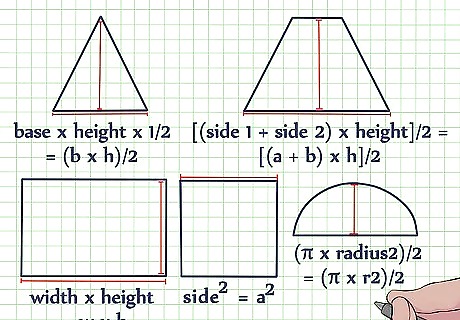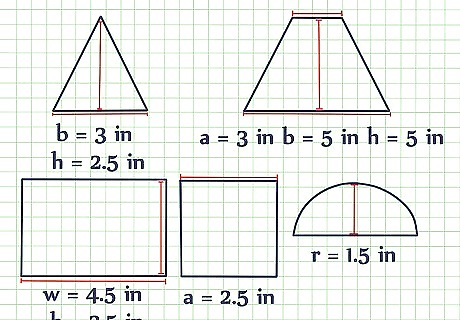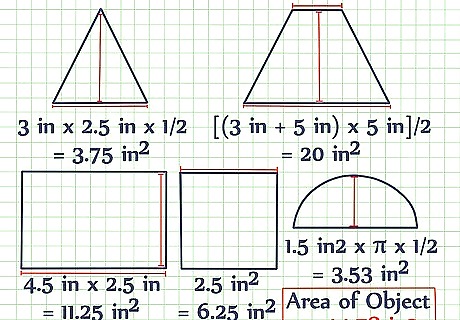
views
- Find the area of an object by multiplying its width by its length.
- Use more specific formulas to calculate the area of more specific shapes. For example, the formula for finding a triangle's area is length x width x 1/2.
- Calculate the surface area of a 3D object by using its specified formula. For example, the formula for finding a cone's surface area is π x r x s + πr2.
How to Find the Area of 2D Shapes
Break down the object into smaller shapes. If you're not working with a simple easily-identifiable shape, like a circle or a trapezoid, then you may be working with a shape that is made up of several other shapes. You have to recognize what those are so you can break the larger object down into a series of smaller objects. In this case, this object is composed of the following shapes: a triangle, a trapezoid, a rectangle, a square, and a semi-circle (half of a circle).

Write down the formulas for finding the area of each of these shapes. These formulas will allow you to use the given measurements of each shape to find their areas. Here are the formulas for finding the area of each shape: Area of a Square = side = a Area of a Rectangle = width x height = w x h Area of a Trapezoid = [(side 1 + side 2) x height]/2 = [(a + b) x h]/2 Area of a Triangle = base x height x 1/2 = (b x h)/2 Area of a Semi-Circle = (π x radius)/2 = (π x r)/2

Write down the dimensions of each shape. Once you write down the formulas, write down the dimensions of each shape so you can plug them in. Here are the dimensions of each shape: Square: a = 2.5 in Rectangle = w = 4.5 in, h = 2.5 in Trapezoid = a = 3 in, b = 5 in, h = 5 in Triangle = b = 3 in, h = 2.5 in Semi-Circle = r = 1.5 in

Use the formulas and dimensions to find the area of each object and add them up. Finding the area of each shape will lead you to find the area of each part of the shape; once you've found the area of each shape using the formula and measurements you were given, all you have to do is add up each area to find the area of the entire object. When calculating area, you have to remember to state the area in square units. The area of the entire object is 44.78 in. Here's how you get it: Find the area of each shape: Area of Square = 2.5 in = 6.25 in Rectangle = 4.5 in x 2.5 in = 11.25 in Trapezoid = [(3 in + 5 in) x 5 in]/2 = 20 in Triangle = 3 in x 2.5 in x 1/2 = 3.75 in Semi-Circle = 1.5 in x π x 1/2 = 3.53 in Add the areas of each shape together: Area of Object = Area of Square + Area of Rectangle + Area of Trapezoid + Area of Semi-Circle Area of Object = 6.25 in + 11.25 in + 20 in + 3.75 in + 3.53 in Area of Object = 44.78 in
How to Find the Surface Area of 3-D Objects

Write down the formulas for finding the surface area of each shape. The surface area is the total area of an object's faces and curved surfaces. Every three dimensional object has a surface area; the volume is the amount of space taken up by the object. Here are the formulas for finding the surface area of a variety of objects: Surface area of a square = 6 x side = 6s Surface area of a cone = π x radius x side + π x radius = π x r x s + πr Surface area of a sphere = 4 x π x radius = 4πr Surface area of a cylinder = 2 x π x radius + 2 x π x radius x height = 2πr + 2πrh Surface area of a square-based pyramid = side of base + 2 x side of base x h = b + 2bh

Write down the dimensions of each shape. Here they are: Cube = side = 3.5 in Cone = r = 2 in, h = 4 in Sphere = r = 3 in Cylinder = r = 2 in, h = 3.5 in Square-Based Pyramid = b = 2 in, h = 4 in

Calculate the surface area of each shape. Now, all you have to do is plug the dimensions of each shape into the formula for finding the surface area of each shape and you're all done. Here's how you do it: Surface area of the cube = 6 x 3.5 = 73.5 in Surface area of the cone = π(2 x 4) + π x 2 = 37.7 in Surface are of the sphere = 4 x π x 3 = 113.09 in Surface are of the cylinder = 2π x 2 + 2π(2 x 3.5) = 69.1 in Surface area of the square-based pyramid = 2 + 2(2 x 4) = 20 in














Comments
0 comment